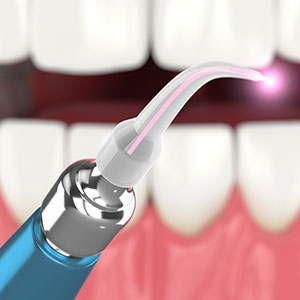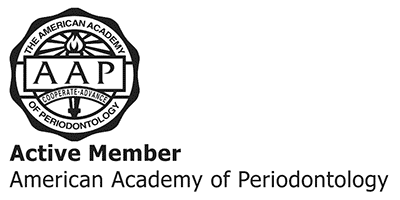What is Periodontal Disease?
Periodontal disease is a progressive bacterial gum infection that can undermine the soft tissue and bone support for the teeth.
(The Greek/Latin meaning of ‘perio’ is ‘support’ and ‘odont’ is ‘tooth’.)
Signs and symptoms of periodontal disease include inflammation and swelling of gum tissue, gum recession and bleeding gums.
Periodontal (Gum) Disease
Periodontal disease begins during a normal stage of the digestive process: when we eat, oral bacteria produce acids to break down carbohydrates and sugars in everyday foods. If this bacteria is not removed soon after eating, a thin, sticky and colorless film coats the teeth. This film is dental plaque.
Dental plaque gives us that ‘fuzzy’ feeling on our teeth when we need to brush. If plaque is not removed by brushing and flossing, it can harden into calculus deposits, which produce toxins that contribute to gum infection, or periodontal disease.
Dental calculus deposits cannot be removed by brushing or flossing. Your dentist and dental hygienist must remove this buildup (also known as tartar) with dental instruments and ultrasonic cleaning systems. If it is not removed, tartar will continue to form below the gum line on the tooth root surfaces. This causes the gums to pull away from the tooth, forming deepened ‘pockets’ between the gums and the teeth.
Without intervention, advanced gum infection advances beneath the tooth root into the jaw bone, destroying the bone structure. Bone and soft tissue do not ‘regenerate’ (produce new growth) properly in the presence of infection. Without adequate support, teeth in the affected area will become loose and require extraction.
Periodontal disease does not usually hurt. Early warning signs are bad breath and bleeding gums, however not everyone has these symptoms. A CDC study revealed that “one out of every two American adults aged 30 and over has periodontal disease.” (perio.org)
How is Periodontal Disease Diagnosed?
During your regular dental examinations, your dentist, periodontist or dental hygienist will review your dental x-rays to look for signs of bone loss and ‘measure’ the depth of the periodontal pockets (areas between the teeth and the gums) using a small instrument that looks like a ruler. An indication of periodontal disease would be pocket depths greater than 4 millimeters; this is a sign that there may be active infection.
What are the Stages of Periodontal Disease?
Fortunately, early detection of periodontal disease can help avoid bone deterioration and tooth loss. Periodontal infection generally progresses in stages, with more risks associated with advanced disease.
Gingivitis
Considered ‘Stage 1’ of periodontal infection, gingivitis occurs when hard calculus deposits form on the teeth above and below the gums. This causes the gums to become inflamed and bleed easily. At this stage, there is typically no bone loss visible on dental x-rays.
Dr. O'Neal or your dentist can generally treat this stage of gum infection in 2-3 appointments, with regular follow-up visits every 3-4 months. During these appointments, the hygienist and doctor will remove the hard deposits from the tooth and tooth root surfaces and apply anti-bacterial medications to reduce the level of bacteria in the periodontal pockets.

Periodontal specialist Dr. Cheria O'Neal utilizes laser periodontal therapy in the treatment of gingivitis. The dental laser applies water and laser energy to break down and remove calculus from the tooth surfaces and destroy harmful bacteria. The dental laser interacts with the soft tissue, bone and tooth structure to promote healing and achieve periodontal pocket reduction.
Moderate Periodontitis
‘Moderate’ Periodontitis is considered ‘Stage 2’ periodontal disease. In this stage, periodontal measurements of 4 to 5 millimeters throughout the mouth, with evidence of bone loss on the dental x-rays, are common signs found during a periodontal assessment. The gums may or may not bleed. There is usually no pain associated with moderate periodontitis, making it difficult for the patient to notice.
Treatment of moderate periodontitis involves removal of hard deposits and toxins from the tooth and tooth root surfaces by the dentist, periodontist or dental hygienist. This procedure, referred to as ‘root planing’ is usually performed under local anesthetic administered by the doctor. The goal of root planing is to create smooth, clean root surfaces to promote healing beneath the gum line.
Root planing treatments are generally provided in sections of the mouth, i.e., quadrants (upper left, upper right, lower left, lower right), or a combination of quadrants.
Dr. O'Neal frequently uses the dental laser in root planing procedures. The fine instrument of the dental laser is used to remove hard deposits and diseased tissue. The dental laser is less invasive than traditional surgical instruments, requiring less anesthetic and reducing post-treatment discomfort. The laser also effectively disinfects the pockets to reduce bacteria levels.
If the periodontal infection is generalized through the mouth, root planing generally takes 2 to 4 appointments to complete, with follow up visits every 1-3 months. During these appointments, Dr. O'Neal will maintain the cleanliness of the teeth and root surfaces, as well as apply the laser to reduce bacteria levels and stimulate new tissue growth.
Advanced Periodontal Disease
Signs of advanced periodontal disease include: teeth that are loose, severe gum recession and periodontal pocket measurements greater than 5 millimeters. In addition to root planing and periodontal laser therapy, Dr. O'Neal may recommend periodontal surgery.
During periodontal surgery, Dr. O'Neal will access the areas around the roots of the affected teeth via a ‘periodontal flap’ procedure. This will expose the tooth roots and allow her to use the dental laser to remove diseased soft tissue and calculus deposits from tooth structures.
In cases of bone defects or severe bone loss, Dr. O'Neal may also recommend bone re-contouring (osseous surgery), or bone or soft tissue graft surgery.
The goal of periodontal surgery is to stop the progression of periodontal disease and restore what has been lost to encourage regeneration of healthy bone and gum tissue.
The Mouth Body Connection
Because periodontal disease is an infection that causes inflammation in the body, it is an overall health concern. Studies continue to reveal how bacteria related to periodontal disease can have a negative impact on health; this is especially troubling for patients with systemic illnesses such as diabetes or heart disease.
Certain medications can make a person more susceptible to periodontal disease, as well as conditions that are related to chronic inflammation, such as cancer, heart disease or rheumatoid arthritis. Genetics, substance abuse, stress, aging, poor nutrition and smoking can also be contributing factors to the development of periodontal disease.
Prevention is the Best Defense against Periodontal Disease
With good daily habits and regular dental visits, it is possible to prevent periodontal disease. A daily routine of brushing twice a day and flossing once per day is the tried and true standard.
It is especially important to thoroughly clean your mouth before you go to bed. During sleep, saliva movement is slower and bacteria in the mouth are more active; diligent brushing and flossing at bedtime can help reduce bacteria levels to a minimum.
We all need support from dental health professionals to keep our teeth and gums healthy. The American Dental Association® recommends that you visit your dentist for an exam and hygiene maintenance 2-4 times per year with x-rays as needed to watch for tooth decay or bone loss.
If you have been diagnosed with periodontal disease previously, your dentist may recommend that you alternate your hygiene visits with periodontal specialist Dr. Cheria O'Neal to monitor the health of the gum tissue and bone.
If you have questions about periodontal disease or the role of the periodontist, please do not hesitate to Contact our O'Neal Periodontics Team.
